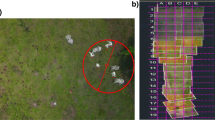Abstract
Mother-young relationships, up to the third month of the calves’ life, were investigated in European bisonBison bonasus (Linnaeus, 1758) from Białowieża National Park breeding centres (Poland). During the first week, calves spent most of their time close to their mothers and were rarely seen in the vicinity of other group members. Highest suckling rate, most frequent vocal contact and agonistic behaviour of mothers towards intruders, were other characteristics of this period. Although being a forest species, European bison exhibit a following type of strategy for offspring protection, typical for ungulates living in open areas; no hiding phase was observed. Suckling rates were similar in calves of both sexes, however, the pattern of nursing was different: male calves suckled longer, but in rarer bouts than female calves. The mothers’ condition, reflected by their social rank, did not influence the suckling rate. No sex differences were recorded in other maternal activities or mother-calf distance. The presumption of a lack of sex-biased maternal investment in European bison is confirmed by the results of other research.
Similar content being viewed by others
References
Altmann J. 1974. Observational study of behavior. Behaviour 49: 227–267.
Byers J. A. and Moodie J. D. 1990. Sex-specific maternal investment in pronghorn, and the question of a limit on differential provisioning in ungulates. Behavioural Ecology and Sociobiology 26: 157–164.
Caboń-Raczyńska K., Krasińska M., Krasiński Z. A. and Wójcik J. M. 1987. Rhytm of daily activity and behavior of European bison in the Białowieża Forest in the period without snow cover. Acta Theriologica 32: 335–372.
Caley J. M. and Nudds T. D. 1987. Sex-ratio adjustment inOdocoileus: does local resource competition play a role? The American Naturalist 129: 452–457.
Carl G. R. and Robbins C. T. 1988. The energetic cost of predator avoidance in neonatal ungulates: hiding versus following. Canadian Journal of Zoology 66: 239–246.
Cassinello J. 1996. High-ranking females bias their investment in favour of male calves in captiveAmmotragus lervia. Behavioural Ecology and Sociobiology 38: 417–424.
Clark A. B. 1978. Sex ratio and local resource competition in a prosimian primate. Science 201: 163–165.
Clutton-Brock T., Albon S. D. and Guiness F. E. 1984. Maternal dominance, breeding success and birth sex ratios in red deer. Nature 308: 358–360.
Clutton-Brock T., Guiness F. E. and Albon S. D. 1982. Red deer, behavior and ecology of two sexes. University of Chicago Press, Chicago: 1–378.
Daleszczyk K. and Krasiński Z. A. 2001. Parturition behaviour of European bisonBison bonasus (L.) living in reserves. Folia Zoologica 50: 75–78.
Egerton P. J. M. 1962. The cow-calf relationship and rutting behavior in the American bison. MSc thesis, University of Alberta, Edmonton: 1-155.
Estes R. D. and Estes R. K. 1979. The birth and survival of wildebeest calves. Zeitschrift für Tierpsychologie 50: 45–95.
Fisher D. O., Blomberg S. P. and Owens I. P. F. 2002. Convergent maternal care strategies in ungulates and macropods. Evolution 56: 167–176.
Geist V. 1971. Mountain sheep. The University of Chicago Press, Chicago: 1–248.
Green W. C. H. 1992a. Social influences on contact maintenance interactions of bison mothers and calves: group size and nearest-neighbour distance. Animal Behaviour 43: 775–785.
Green W. C. H. 1992b. The development of independence in bison: pre-weaning spatial relations between mothers and calves. Animal Behaviour 43: 759–773.
Green, W. C. H. and Rothstein A. 1991. Sex bias or equal opportunity? Patterns of maternal investment in bison. Behavioural Ecology and Sociobiology 29: 373–384.
Hewison A. J. M. and Gaillard J.-M. 1999. Successful sons or advantaged daughters? The Trivers-Willard model and sex-biased maternal investment in ungulates. TREE 14: 229–234.
Kojola I. 1998. Sex ratio and maternal investment in ungulates. Oikos 83: 567–573.
Krasińska M. and Krasiński Z. A. 2002. Body mass and measurements of the European bison during postnatal development. Acta Theriologica 47: 85–106.
Lavigueur L. and Barrette C. 1992. Suckling, weaning, and growth in captive woodland caribou. Canadian Journal of Zoology 70: 1753–1766.
Lent P. C. 1974. Mother-infant relationships in ungulates. IUCN Publications new series 24: 14–55.
Lott D. F. 1974. Sexual and aggressive behavior of adult male American bison (Bison bison). IUCN Publications new series 24: 382–394.
McHugh T. 1958. Social behavior of the American buffalo (Bison bison bison). Zoologica 43: 1–40.
Oftedal O. T. 1985. Pregnancy and lactation. [In: Bioenergetics of wild herbivores. R. J. Hudson and R. G. White, eds]. CRC Press, Inc., Boca Raton, Florida: 215–238.
Pucek Z. P. 1986.Bison bonasus (Linnaeus, 1758) — Wisent. [In: Handbuch der Säugetiere Europas. J. Niethammer and F. Krapp, eds]. Akademische Verlagsgeselschaft, Wiesbaden. Bd. 2/II. Paarhufer-Artiodactyla: 278–315.
Ralls K., Kranz K. and Lundrigan B. 1986. Mother-young relationships in captive ungulates: variability and clustering. Animal Behaviour 34: 134–145.
Rutberg A. T. 1983. Factors influencing dominance status in American bison cows (Bison bison). Zeitschrift für Tierpsychologie 63: 206–212.
Rutberg A. T. 1986. Lactation and fetal sex ratios in American bison. The American Naturalist 127: 89–94.
Shaw J. H. and Carter T. S. 1989. Calving pattern among American bison. The Journal of Wildlife Management 53: 896–898.
StatSoft. 1984-2003. STATISTICA version 6.1. StatSoft, Inc., Tulsa, USA.
Trivers R. L. and Willard D. E. 1973. Natural selection of parental ability to vary the sex ratio of offspring. Science 179: 90–92.
Walther F. 1979. Das Verhalten der Hornträger (Bovidae). Handbuch der Zoologie 10: 1–184.
Wettemann R. P., Turman E. J., Wyatt R. D. and Totusek R. 1978. Influence of suckling intensity on reproductive performance of range cows. Journal of Animal Sciences 47: 342–346.
Wróblewski K. 1927. [The European bison of Białowieża Primeval Forest]. Wydawnictwo Polskie, Poznań: 1–232. [In Polish]
Author information
Authors and Affiliations
Additional information
Associate Editor was Andrzej Zalewski.
Rights and permissions
About this article
Cite this article
Daleszczyk, K. Mother-calf relationships and maternal investment in European bisonBison bonasus . Acta Theriol 49, 555–566 (2004). https://doi.org/10.1007/BF03192598
Received:
Accepted:
Issue Date:
DOI: https://doi.org/10.1007/BF03192598




